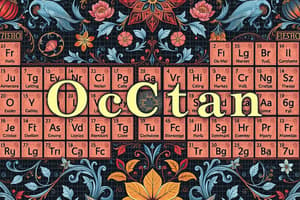Podcast
Questions and Answers
What are the vertical columns on the periodic table called?
What are the vertical columns on the periodic table called?
Groups
What are the horizontal rows on the periodic table called?
What are the horizontal rows on the periodic table called?
Periods
Most of the elements in the periodic table are classified as what?
Most of the elements in the periodic table are classified as what?
Metals
What are the elements that touch the zigzag line classified as?
What are the elements that touch the zigzag line classified as?
The elements in the far upper right corner of the periodic table are classified as what?
The elements in the far upper right corner of the periodic table are classified as what?
Elements in the first group that have one outer shell electron and are extremely reactive are called what?
Elements in the first group that have one outer shell electron and are extremely reactive are called what?
What does it mean when properties of elements have a regular repeating pattern?
What does it mean when properties of elements have a regular repeating pattern?
The elements in the periodic table are arranged by what?
The elements in the periodic table are arranged by what?
Elements in the second group that have 2 outer shell electrons and are also very reactive are called what?
Elements in the second group that have 2 outer shell electrons and are also very reactive are called what?
Elements in groups 3 through 12 that have many useful properties are called what?
Elements in groups 3 through 12 that have many useful properties are called what?
What are elements in group 17 known as?
What are elements in group 17 known as?
Elements in group 18 that are very unreactive are referred to as what?
Elements in group 18 that are very unreactive are referred to as what?
The elements at the bottom of the periodic table that were pulled out to keep the table from becoming too long are called what?
The elements at the bottom of the periodic table that were pulled out to keep the table from becoming too long are called what?
The second period at the bottom of the periodic table is called what?
The second period at the bottom of the periodic table is called what?
What describes the chemical and physical properties of elements as periodic functions of their atomic numbers?
What describes the chemical and physical properties of elements as periodic functions of their atomic numbers?
Flashcards are hidden until you start studying
Study Notes
Periodic Table Overview
- Groups refer to the vertical columns of the periodic table, indicating elements with similar properties.
- Periods are the horizontal rows, signifying elements that have the same number of electron shells.
Element Classifications
- Metals constitute the majority of the periodic table and are typically good conductors of heat and electricity.
- Metalloids are elements located along the zigzag line in the periodic table, displaying properties of both metals and nonmetals.
- Nonmetals are found predominantly in the upper right corner and are generally poor conductors and more varied in properties than metals.
Special Groups of Elements
- Alkali Metals are found in group 1, characterized by having one outer shell electron, making them highly reactive.
- Alkaline Earth Metals are in group 2, with two outer shell electrons, also displaying high reactivity.
- Transition Metals occupy groups 3 to 12 and possess diverse and useful properties, often used in structural and chemical applications.
- Halogens, located in group 17, are termed "salt formers" due to their ability to react with metals to form salts.
- Noble Gases, found in group 18, are noted for being very unreactive and are often referred to as "inert" gases.
Additional Periodic Trends
- The atomic number represents the number of protons in an element and is the primary basis for the arrangement of elements in the periodic table.
- The term periodic describes the regular and repeating patterns of properties seen among elements as you move across the table.
Special Categories of Elements
- Lanthanides are the first series of elements located at the bottom of the periodic table, known for their rare earth properties.
- Actinides are the second series at the bottom, which includes radioactive elements, some of which are man-made.
Fundamental Principle
- Periodic Law states that the chemical and physical properties of elements are periodic functions of their atomic numbers, establishing the foundational concept behind the organization of the periodic table.
Studying That Suits You
Use AI to generate personalized quizzes and flashcards to suit your learning preferences.




